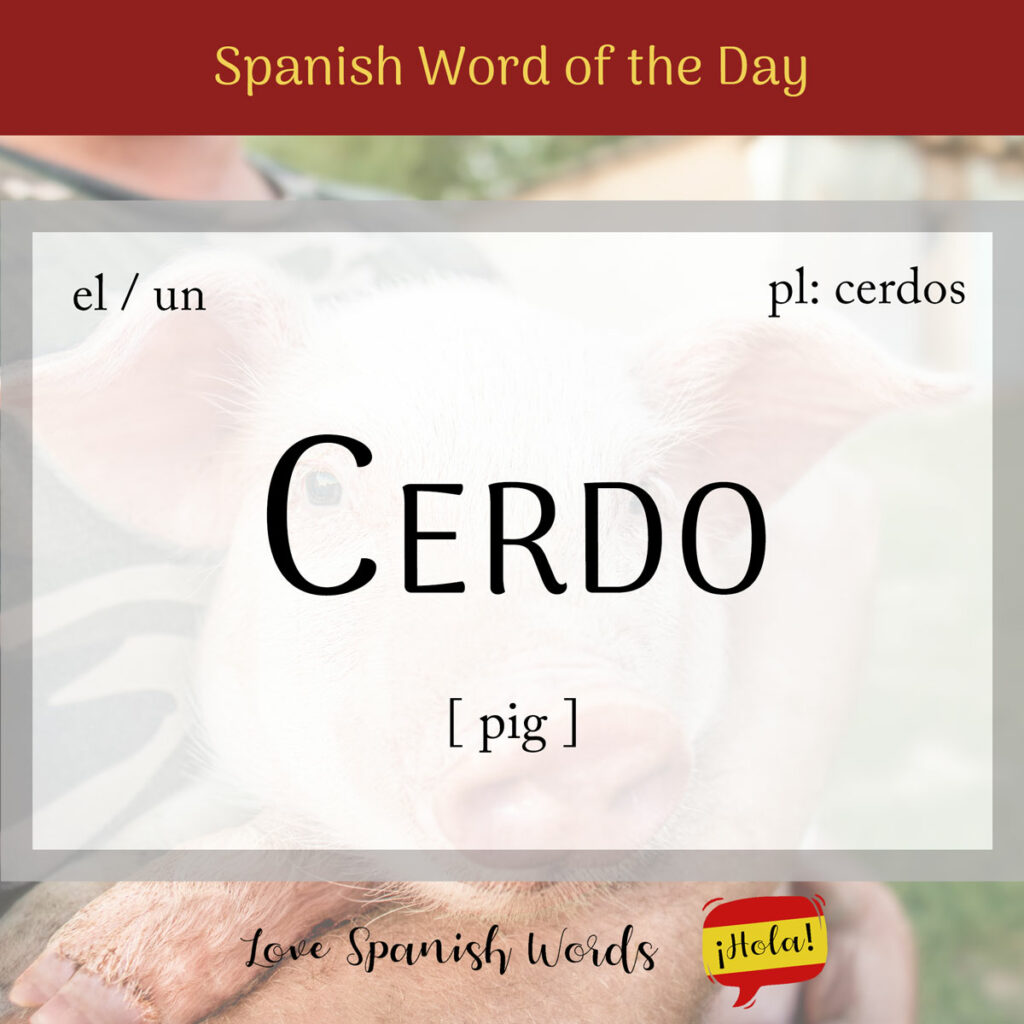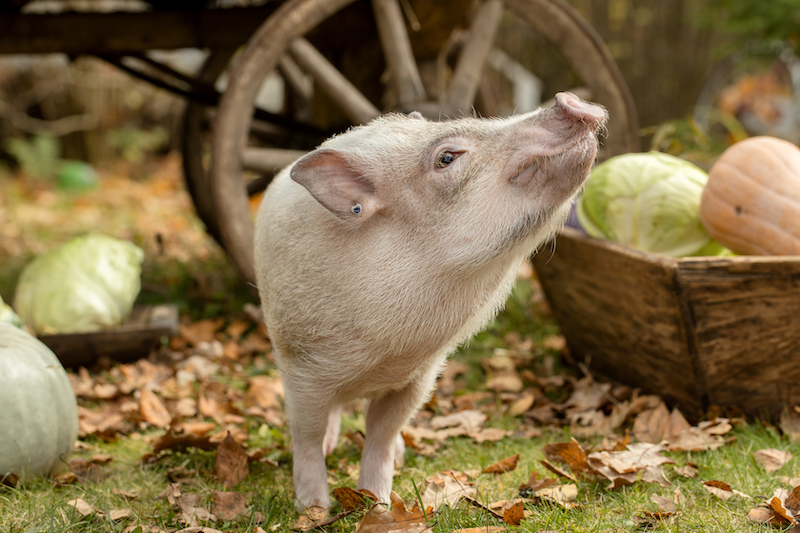The word cerdo, meaning pig in English, comes from the Latin word cervus. It referred to a stag or deer, but in the transition to Vulgar Latin and eventually into Spanish, it came to refer to the domesticated pig. The itself word also evolved and became cerdo with time.
Latin American Pronunciation
European Pronunciation

Cerdo is a masculine noun and it takes the following definite and indefinite articles:
- el cerdo = the pig
- los cerdos = the pigs
- un cerdo = a pig
- unos cerdos = some pigs
Although cerdo is used in its masculine form the majority of the time, occasionally you might hear someone call a pig by its feminine form – la cerda – if they know the pig’s gender.
El cerdo está buscando comida en el jardín.
The pig is searching for food in the garden.
Cerdos are fascinating creatures that are usually domesticados (domesticated) and belong to the Suidae family. They are important both on granjas (farms) and in the naturaleza (wild).
We recognize cerdos by their distinctive physical features. They have a large, round body and pink, black, brown, or spotted skin. One of the most notable features of a pig is its hocico (snout), which is long and flexible. They use it to dig into the ground and search for food.
El cerdo es rosado y tiene una cola rizada
The pig is pink and has a curly tail.
Cerdos also have colas rizadas (curly tails) and either floppy or upright ears depending on their breed. Their feet have pezuñas (cloven hooves), meaning each hoof is divided into two parts to help them navigate various types of terrain.
Baby pigs are known as lechones (piglets), or lechón in their singular form. They are born in a camada (litter). The mother is called a sow in English, which is cerda in Spanish, as we saw above.

Fun Facts:
The term piggy bank which is cochinito , hucha, alcancía or cerdito in Spanish, has an interesting origin. In the Middle Ages, money boxes were often made from a type of clay called pygg, which is how the term came to be associated with the pig-shaped money boxes we know today.
Cerdos are omnívoros (omnivores), meaning they eat various types of food. Their diet typically includes vegetales (vegetables), frutas (fruits), granos (grains), raíces (roots), and sometimes even small animales (animals) or insectos (insects). Their flexible snout helps them forage for a range of different foods. In addition, it comes with such an incredible sense of smell that it helps them find food buried underground.
When they live on farms, cerdos are fed specially prepared pig feed to ensure they get all the necessary nutrients to stay healthy and strong. Farmers do this because pigs are a popular food in the kitchen, which we refer to as pork when the pig becomes food.
Some popular foods and terms using the word cerdo include:
- carne de cerdo = pork meat
- cerdo asado = roasted pork
- chicharrón de cerdo = pork rinds
- jamón de cerdo = pork ham
- lomo de cerdo = pork loin
- salchicha de cerdo = pork sausage
- panceta de cerdo = pork belly
- costillas de cerdo = pork ribs
- lechón = piglet meat
Besides these pork foods, many popular foods come from it. Here are some food derivatives:
- tocino = bacon
- jamón = ham
- chorizo = sausage with spices
- salchicha = sausage
Me gusta mucho comer chicharrones de cerdo.
I like eating pork rinds a lot.
Surprisingly, cerdos are social and highly intelligent, which allows them to learn tricks, play games, and solve problems. Some people believe cerdos might be as smart or even smarter than dogs. Since they are social animals, pigs can form strong bonds with humans like dogs do.
Although cerdos have a bad reputation for being sucios (dirty), they are actually quite clean. They like their living areas to be tidy. However, they roll in lodo (mud) and get dirty to stay cool and regulate their temperatura corporal (body temperature). Being covered in mud also serves as a sun protectant against sunburn and it helps keep insects away.

Fun Facts:
Have you ever heard the saying I’m sweating like a pig? In Spanish, you would say Estoy sudando como un cerdo.
However, pigs do not have sweat glands and are unable to sweat. This is why they roll in mud to cool off. This means the phrase Sudando como cerdo would actually mean you aren’t sweating!
On that note, cerdos do have skin structures similar to apocrine sweat glands. They can lose water through their skin at temperatures below a critical point.
Similar to how a pig has many names in English such as swine, slob, pork, boar, piglet, and hog, the Spanish language also has numerous ways to call a pig besides cerdo. Some are formal and some are colloquial. Let’s look at a few starting with formal names.
Porcino (porcine) is an animal related to the pig. This term is used in technical and scientific contexts. Lechón (piglet) is a young pig. This is a formal kitchen term used to refer to young pig meat that is consumed.
There are also many colloquial and regional terms for a pig. In some parts of Latin America such as Argentina and Chile, it’s referred to as chancho.
A popular way to call a pig is puerco or puerquito. Puerquito is the diminutive form to refer to a small pig or a cute pig. Similar to how you can metaphorically refer to someone as a pig in English, you can also call them puerco as an insult in Spanish.
Marrano is another term used to refer to a pig in different regions in Latin America and Spain. This term can have a negative connotation if used colloquially to insult someone. Similar to puerco, you can call someone a marrano as an insult to eating a lot or being dirty.
Gorrino is another name for cerdo. It’s used in certain regions of Spain. Pichón is a term that means young bird but is sometimes used in rural contexts to refer to a young pig.
Cochi and cochinito is another informal way to refer to the pig in parts of Latin America, such as Mexico. You can call a person cochino or cochina if they are dirty or do something dirty. It sounds similar to cochon, which is one way to call pigs in French. A “piggy bank” in Spanish is called a cochinito in some parts of Latin America.
La cerda se revolcó en el barro para refrescarse.
The pig rolled in the mud to cool off.

Spanish metaphors and phrases featuring ‘cerdo‘
The word cerdo appears in various idioms and metaphors. Here are some common ones:
No hay cerdo sin rastro means There’s no smoke without fire in English. This metaphor implies that every rumour or piece of gossip has some truth behind it.
Tener más vida que un cerdo en matadero in English means To have more life than a pig in the slaughterhouse. It means to be very resilient or to survive despite difficult circumstances.
Coger al cerdo por las orejas translates to Catch the pig by the ears. This metaphor means a person chooses to handle a difficult situation with care or decides to take control of a tough situation.
Spanish idioms featuring ‘cerdo‘
Ser un cerdo
Literal translation: to be a pig
English meaning: to be rude or dirty
Comer como cerdo
Literal translation: to eat like a pig
English meaning: to eat a lot
Hacer un cerdo
Literal translation: to do a pig
English meaning: to make a mess or behave messily

